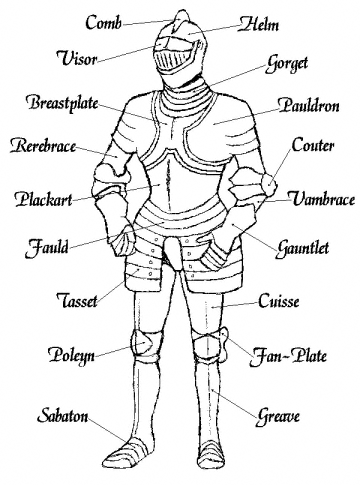
| The knight was one of three types of fighting men during the middle ages: Knights, Foot Soldiers, and Archers. The medieval knight was the equivalent of the modern tank. He was covered in multiple layers of armor, and could plow through foot soldiers standing in his way. No single foot soldier or archer could stand up to any one knight. Knights were also generally the wealthiest of the three types of soldiers. This was for a good reason. It was terribly expensive to be a knight. The war horse alone could cost the equivalent of a small airplane. Armor, shields, and weapons were also very expensive. Becoming a knight was part of the feudal agreement. In return for military service, the knight received a fief. In the late middle ages, many prospective knights began to pay "shield money" to their lord so that they wouldn't have to serve in the king's army. The money was then used to create a professional army that was paid and supported by the king. These knights often fought more for pillaging than for army wages. When they captured a city, they were allowed to ransack it, stealing goods and valuables. |
 © Chivalry Sports, Inc. Used with permission. |
| Becoming a Knight: There were only a few ways in which a person could become a knight. The first way was the normal course of action for the son of a noble: When a boy was eight years old, he was sent to the neighboring castle where he was trained as a page. The boy was usually the son of a knight or of a member of the aristocracy. He spent most of his time strengthening his body, wrestling and riding horses. He also learned how to fight with a spear and a sword. He practiced against a wooden dummie called a quintain. It was essentially a heavy sack or dummie in the form of a human. It was hung on a wooden pole along with a shield. The young page had to hit the shield in its center. When hit, the whole structure would spin around and around. The page had to maneuver away quickly without getting hit. The young man was also taught more civilized topics. He would be taught to read and write by a schoolmaster. He could also be taught some Latin and French. The lady of the castle taught the page to sing and dance and how to behave in the king’s court. At the age of fifteen or sixteen, a boy became a squire in service to a knight. His duties included dressing the knight in the morning, serving all of the knight’s meals, caring for the knight’s horse, and cleaning the knight’s armor and weapons. He followed the knight to tournaments and assisted his lord on the battlefield. A squire also prepared himself by learning how to handle a sword and lance while wearing forty pounds of armor and riding a horse. When he was about twenty, a squire could become a knight after proving himself worthy. A lord would agree to knight him in a dubbing ceremony. The night before the ceremony, the squire would dress in a white tunic and red robes. He would then fast and pray all night for the purification of his soul. The chaplain would bless the future knight's sword and then lay it on the chapel or church's altar. Before dawn, he took a bath to show that he was pure, and he dressed in his best clothes. When dawn came, the priest would hear the young man's confession, a Catholic contrition rite. The squire would then eat breakfast. Soon the dubbing ceremony began. The outdoor ceremony took place in front of family, friends, and nobility. The squire knelt in front of the lord, who tapped the squire lightly on each shoulder with his sword and proclaimed him a knight. This was symbolic of what occurred in earlier times. In the earlier middle ages, the person doing the dubbing would actually hit the squire forcefully, knocking him over. After the dubbing, a great feast followed with music and dancing. A young man could also become a knight for valor in combat after a battle or sometimes before a battle to help him gain courage. |
 Pads worn under the armor to help ease the weight. They were called gambesons. © Chivalry Sports, Inc. Used with permission. |
 A helmet of the type worn by knights during the crusades. One can see the holes cut in the front. This made it easier for the knight to breathe. | |
Chivalry: Knights believed in the code of chivalry. They promised to defend the weak, be courteous to all women, be loyal to their king, and serve God at all times. Knights were expected to be humble before others, especially their superiors. They were also expected to not "talk too much". In other words, they shouldn't boast. The code of chivalry demanded that a knight give mercy to a vanquished enemy. However, the very fact that knights were trained as men of war belied this code. Even though they came from rich families, many knights were not their families' firstborn. They did not receive an inheritance. Thus they were little more than mercenaries. They plundered villages or cities that they captured, often defiling and destroying churches and other property. Also the code of chivalry did not extend to the peasants. The "weak" was widely interpreted as "noble women and children". They were often brutal to common folk. They could sometimes even rape young peasant women without fear of reprisal, all because they were part of the upper class. |
 These are two examples of medieval shields made of either wood or metal. Normally these would have the knight's emblem or family seal on them. |